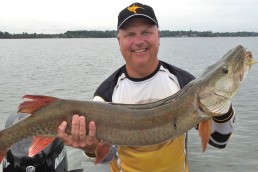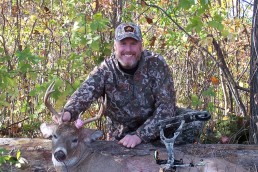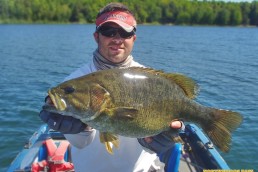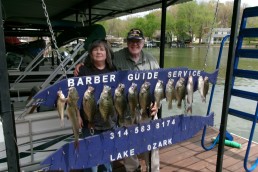Go Small and Shallow for Pressured, Late-summer Muskies
SHARE THIS POST
“That didn’t take long,” I said, followed by, “Get the net!”
My first cast in the shallow, weedy area we were fishing had hooked up a nice muskie. As the fish made a run past the front of the boat, I could see the relatively small spinnerbait that I was using was securely hooked through the top of the muskie’s jaw.
Several runs, some splashing, and one partial jump later, and I unhooked a 47-inch muskie and lifted it up for a quick photo before sliding it back into the water. In the warm, shallow water, the fish was ready to go almost immediately.
“The fish of one cast,” I mused, as I rinsed my hands and the net of muskie slime.
It was caught in the beginning of August and we were on a busy, metro-area lake targeting muskies with a technique I’ve been using the past several seasons for pressured, late-summer fish. We were casting relatively undersized tandem blade safety-pin-style spinnerbaits over and through the thick weeds in 3 to 7 feet. That’s right—it was warm water in the middle of the summer and we were going small and shallow for the lake’s top predators.
I put this pattern together, and largely by accident. For several years while fishing bass in the heat on a couple lakes with good populations, I had witnessed muskies following my bass baits. I then proceeded to catch several nice muskies on these smaller baits. Then one morning I heard a couple of splashes up shallow on a weedline in the deep edge while looking for bass.
I pointed the trolling motor toward these shallow splashes. I then realized the only thing I was going to fish through the dense, shallow weeds was a spinnerbait. I tied on a 1/2-ounce Terminator T1 and tossed it out. On the third cast the bait stopped suddenly, and then headed to the side quickly.
Five minutes later I managed to get a 51-inch muskie into my bass/walleye net enough to grab it for a measure and release. The battle took a while with my bass rod and the 14-pound-test line, but a point had been made and received. On my next muskie-guiding trip to a nearby lake, my clients started out with large muskie baits, but I was casting a bass spinnerbait. My two clients had three follows between them, but I hooked up two muskies on the smaller baits. And then one of the clients managed to land one of them. I was hooked.
Are you enjoying this post?
You can be among the first to get the latest info on where to go, what to use and how to use it!
Now, with the heat of late July and August, I’ll go shallow and small for the muskies, especially on pressured, weedy lakes. I have lots of ideas why this pattern has worked several years.
First, the shallow, dense weeds provide good cover for muskies and are still teeming with food like perch and sunfish, even though these areas are often devoid of anglers now. Those targeting deep water—which is what you are supposed to do in summer—leave the shallows to muskies and their prey. Second, by August, lakes are full of smaller prey due to hatches, and a lot of the larger prey that survived the winter before didn’t survive the spring. This works with the “match the hatch” theory—as old as fishing itself. Finally, on pressured lakes the muskies have seen and followed a lot of large muskie baits up to the boats. Smaller baits might be attractive simply because they haven’t been seen as much by the muskies. Whatever the reason, I can’t ignore the results of targeting late-summer muskies with smaller baits in the shallow weeds.
I’ll also look for muskies now in a few spots in these weedy lakes. My favorite is again a shallow area with weeds, but near where some type of current is coming in. This could include streams, channel areas from another lake, a culvert under a road from a wetland, or any other situation you find with some water, and often food, coming into a lake. The tops of shallow, weedy reefs or points are great too.
Many of the other anglers on the lake might be targeting the deep weed edges of spots like these, but I will hit the top. Inside weed edges by hard-bottom areas are another good spot. And another factor I look for is if the wind is blowing in or if it’s cloudy, or both. If I have to fish these spots on a calm, sunny day, I’ll get out very early and try to hit the best conditions for a bite. Wind blowing into a spot, especially if it is cloudy, can keep fish active later into the day as well, though.
Equipment is pretty simple. And after some long battles and some lost fish with bass tackle as I was putting together this approach, I chose to use typical muskie rods, reels, and line for this technique. I use a 7-foot 9-inch St. Croix Legend Tournament Musky casting rod paired with an Abu Garcia C4 high-retrieve-speed casting reel. I do downsize the line a bit from many muskie techniques, going with 50-pound-test Berkley Trilene Braid Professional Grade superline. This combo is plenty to battle a big fish and get him out of the weeds, and still casts “smaller” baits well. These are ones relatively smaller compared to your traditional muskie baits. I like a 1-ounce tandem blade spinnerbait with either a marabou or a rubber skirt. My two favorites are the Northland Bionic Bucktail and Reed Runner. These are 1 ounce, and they attract muskies yet are light enough to buzz over and through the shallow weeds. The safety-pin-style spinnerbaits with a single hook, or two single inline hooks, are much more weedless than an inline bucktail with one or two treble hooks. These baits, despite 1 ounce, present a large profile due to their shape and design. Don’t let the smaller size dissuade you.
For color, I follow a couple of rules. I always have one bait going in a firetiger or perch color pattern to match the hatch. Muskies in these areas are often feeding on small perch and sunfish that are similar in color. If there is more than one angler casting, I’ll take into account the rule about natural colors (white, silver, gold) in bright conditions and clear water and bright colors in stained water or cloudy conditions. If a muskie follows one color but doesn’t hit it, I’ll be to run a different color through the same area or come back later and cast a different color.
Finally, make sure to do a figure eight after each cast, even in shallower water. We have hooked up a lot of muskies we didn’t even know were there while figure-eighting one of these baits in 3 to 5 feet.
It may sound strange to some, but when the warmer water of late summer arrives and you are after muskies on pressured, weedy lakes, go shallow and go small. You can find a lot of these feeding in the shallow weeds, and often with no other anglers chasing them. The smaller baits above can be fished in this shallow, weedy water, and they’ll often fool even the most tested muskie. Also use your heavy equipment to get these fish out of the weeds and to the boat, and always prepare to have a blast.
MWO
SHARE THIS POST
Did you enjoy this post?
You can be among the first to get the latest info on where to go, what to use and how to use it!
Troy Smutka
Troy Smutka is a central Minnesota fishing guide (greatdayonthewater.com) and a walleye tournament angler. He is also a member of the Lund Boats, Mercury Outboards and Johnson Outdoors Pro Teams, and hosts and produces Fishing and Hunting the North Country on YouTube.



